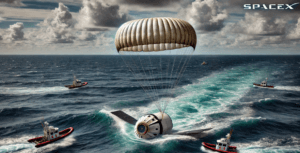NASA Astronauts Sunita Williams and Butch Wilmore Return to Earth After 286 Days in Space
NASA astronauts Sunita Williams and Butch Wilmore returned to Earth after an unexpectedly long 286-day mission in space. Their SpaceX Dragon capsule splashed down safely in the Gulf of Mexico on March 18, 2025. Originally planned as a short mission, their journey was extended due to issues with their initial test flight.
During re-entry, the capsule traveled at 28,800 km/h, generating extreme heat of 1,600°C, but its heat-resistant PICA shield ensured crew safety. The spacecraft deployed parachutes to slow its descent before landing in the ocean. Rescue teams quickly arrived to assist.
Williams and Wilmore, along with NASA’s Nick Hague and Russia’s Aleksandr Gorbunov, emerged from the capsule smiling. Now, they will undergo medical evaluations for muscle and bone loss caused by prolonged space travel. Their mission highlights the challenges and resilience of human space exploration.

NASA Astronauts Sunita Williams and Butch Wilmore Return to Earth After 286 Days in Space
NASA astronauts Sunita Williams and Butch Wilmore have finally returned to Earth after an unexpectedly long stay in space. Originally planned as a much shorter mission, they ended up spending 286 days in orbit—278 days longer than intended. Their journey concluded on March 18, 2025, when they safely landed in the Gulf of Mexico near Tallahassee, Florida, aboard a SpaceX capsule. This marked the end of their extended mission, which began over nine months ago with a challenging test flight.
A Safe but Fiery Return
Sunita Williams and Butch Wilmore successfully returned to Earth after their 286-day space mission. Their SpaceX Dragon capsule splashed down in the ocean off the coast of Florida at 5:57 PM local time. After landing, 59-year-old Williams and 62-year-old Wilmore emerged from the capsule, smiling and waving to the excited crowd. They were accompanied on their journey by NASA astronaut Nick Hague and Russian cosmonaut Aleksandr Gorbunov.
However, their return was not without challenges. As the Dragon capsule re-entered Earth’s atmosphere, it was traveling at an astonishing speed of nearly 28,800 km/h. The friction generated from this rapid descent caused the capsule’s exterior to heat up to approximately 1,600 degrees Celsius, transforming it into a glowing fireball. Fortunately, the astronauts were safeguarded by the capsule’s heat-resistant shields, which successfully withstood the extreme temperatures.
How the Capsule Survived the Heat
While docked at the International Space Station (ISS), the Dragon capsule remained in a near-vacuum environment. Following a series of precisely controlled maneuvers, it began its descent toward Earth. Upon re-entry, the intense friction with the atmosphere produced extreme heat. However, the capsule’s outer shell, constructed from a heat-resistant material called Phenolic-Impregnated Carbon Ablator (PICA), absorbed and deflected the heat, ensuring the safety of the crew. By the time it reached the ocean, the once-white capsule had turned brown due to the harsh conditions it had endured.
A Smooth and Controlled Landing
To guarantee a safe landing, the Dragon spacecraft deployed two drogue parachutes to stabilize its descent after atmospheric re-entry. Just before touching down in the water, four additional parachutes were released, further slowing the capsule’s speed to approximately 25 km/h. Once the capsule splashed down, rescue teams swiftly arrived to inspect for gas leaks before opening the hatch.
A Joyful Homecoming
The first to exit the capsule was Nick Hague, followed by Aleksandr Gorbunov. Then came the moment the world had been waiting for—Sunita Williams, whose originally short mission turned into an extended nine-month stay in space, stepped out, beaming and waving. Lastly, Butch Wilmore emerged, officially concluding their incredible journey.
Recovery and Health Checks
Now back on Earth, Williams and Wilmore will undergo comprehensive medical evaluations. Prolonged exposure to microgravity can lead to muscle and bone loss, as well as other health concerns like radiation exposure and vision changes. NASA doctors will closely monitor their recovery in the coming weeks.
Their return not only marks the conclusion of an extraordinary mission but also underscores the resilience and dedication of astronauts who continue to push the boundaries of space exploration. Despite the challenges, their safe return serves as a testament to advancements in space technology and the unwavering spirit of human exploration.
You must be logged in to post a comment.